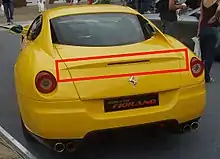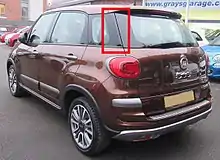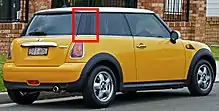


In automotive design, a nolder is a small aerodynamic shape (a strip, wing, protrusion, lip or profile) integral to bodywork or to an aerodynamic attachment – e.g., a spoiler, diffuser or splitter – perpendicular to the direction of air flow travel[1] for the purpose of further managing and refining air flow.
Nolders are used in both high-performance as well as in less critical aerodynamic applications.
Etymology
In 1996, Autocar attributed original use of the term to Ferrari,[2] with other sources citing the nolder as having derived from Formula One racing,[3] where Ferrari has been prominent.
The Formula One Dictionary defines a nolder as "a small upside-down L-shaped aerodynamic appendage generally positioned on the trailing edge of the rear wing to increase downforce at low speed."[4]
The Automotive Dictionary defines it as a "very small aerodynamic appendage that's fitted to an airfoil to increase down-force without affecting drag resistance."[5]
Applications
In the design of high-performance vehicles, a nolder of limited size can significantly increase or decrease the lift (Cz) of a vehicle's aerodynamic profile.[1]
Nolders are also used in less high-performance applications, for example forcing an airflow separation alongside a vertical rear window to minimize debris accumulation, e.g., with a small hatchback.
Examples
Examples include the underside of the LaFerrari, which features a nolder to assist with vehicle dynamics.[6] The Ferrari 599 GTO features prominent flanking aerodynamic fins or flying buttresses aside the rear window, maximizing air flow to a linear rear nolder.[7] The Ferrari 355 has a similar nolder profile at the upper portion of its tail.[8]
The Koenigsegg CCXR features an optional front splitter with a nolder,[9] and the spoiler at the rear bumper of the Maserati 320S features a supplementary nolder to increase the vertical load to the rear.[10]
Early versions of the highly aerodynamic 1982 Ford Sierra suffered crosswind instability, which was addressed in 1985 with the addition of aerodynamic nolders on the rear edge of the rubber seals of the rear-most side windows.
For airflow management and to assist in keeping the rear window free from dirt, nolders are integral to the rearmost vertical pillar of Mini Cooper models and the Fiat 500L.[11]
See also
References
- 1 2 Paolo Scalera (February 17, 2017). "Aerodynamics, the war on winglets: a race against the wind". Gpone.com. Archived from the original on January 15, 2018. Retrieved January 14, 2018.
Very soon, in addition to internal spoilers, we will begin to talk about 'nolders': these are short and thin flaps placed at the ends of the spoiler output in a position roughly perpendicular to the flow. It is a small strip placed at its maximum inclination and it allows Cz to be significantly increased when the winglets have limited dimensions.
- ↑ "Autocar, Volume 209". Haymarket Motoring Pub., 1996. 1996. Archived from the original on 2022-08-28. Retrieved 2018-01-15.
Then you discover the driving position is close to flawless. No offset pedals, no unreadable gauges, a gorgeous airbag steering wheel that moves in and out, up and down, and terrific visibility, especially to the rear - although it's impossible to see the aerodynamic lip ( Ferrari calls it a nolder, a term we've not heard before ) at the extreme of the tail.
- ↑ "Ferrari 360 Spider". Scuderia Ferrari Club Parma. Archived from the original on 2018-01-15. Retrieved 2018-01-15.
Per raggiungere questo carico verticale era stato inserito un nolder (una protuberanza montata in prossimità dell'angolo di coda, soluzione ripresa dalla Formula1).
- ↑ "Dizionario della F1". Virgilio.it. Archived from the original on 2017-12-28. Retrieved 2018-01-15.
Nolder Piccola appendice aerodinamica a forma di L rovesciata posizionata generalmente sul bordo di uscita dell'alettone posteriore. La sua funzione è quella di aumentare deportanza a bassa velocità.
- ↑ "Il Dizionario del Automobilismo". Quipo.it. Archived from the original on 2018-01-15. Retrieved 2018-01-15.
Il nolder è un' appendice aerodinamica molto piccola che si inserisce liberamente ai profili degli alettoni. Aumenta l'aerodinamica ma non influisce sulla resistenza all'avanzamento.
- ↑ "LaFerrari". egarage.com. 8 March 2013. Archived from the original on 2018-01-15. Retrieved 2018-01-14.
The engine compartment ends in a full-width nolder beneath which is concealed an unprecedented active aerodynamic device.
- ↑ "Carbon Fiber Aerodynamic Fins" (PDF). Ferrari.com. Archived (PDF) from the original on 2018-01-15. Retrieved 2018-01-14.
The aerodynamic fins are the side view's most distinguishing characteristic and technically speaking, their contribution is vital for achieving the aerodynamic load goals required at high speed since they channel and maximize the air flow towards the nolder.
- ↑ "Ferrari #355". Drivetribe.com. Archived from the original on 2018-01-15. Retrieved 2018-01-14.
Aerodynamic designs for the car included over 1,300 hours of wind tunnel analysis. The car incorporates a Nolder profile on the upper portion of the tail, and a fairing on the underbody that generates downforce when the car is at speed.
- ↑ "CCXR Koenigsegg". Koenigsegg.com. Archived from the original on 2018-01-15. Retrieved 2018-01-14.
- ↑ "Maserati 320S". Maserati-Alfieri. Archived from the original on 2017-08-04. Retrieved 2018-01-14.
- ↑ "Tecnica Fiat 500L Motori Comfort Materiali, Page 32 of 35". Autombilismo.it. September 21, 2012. Archived from the original on September 23, 2015. Retrieved January 14, 2018.